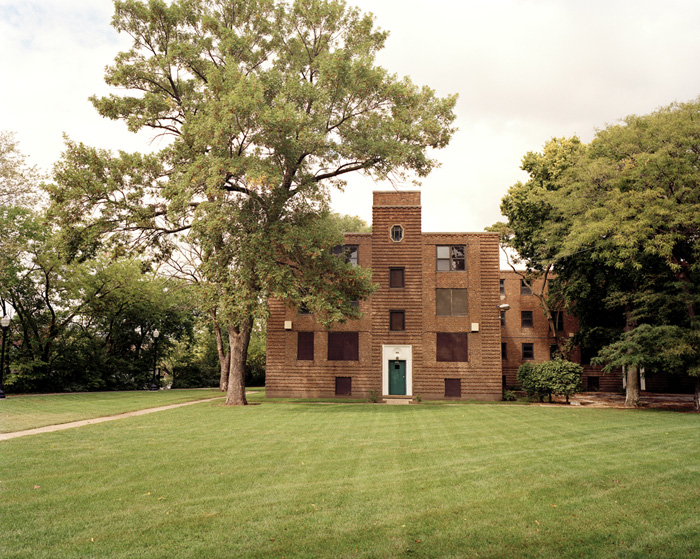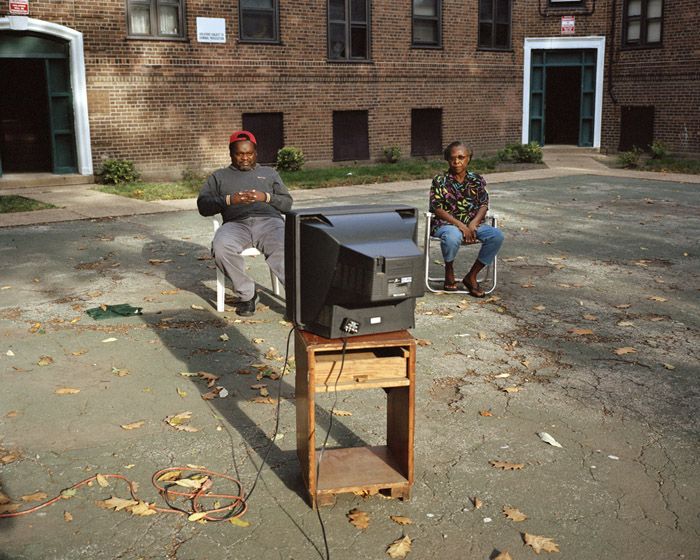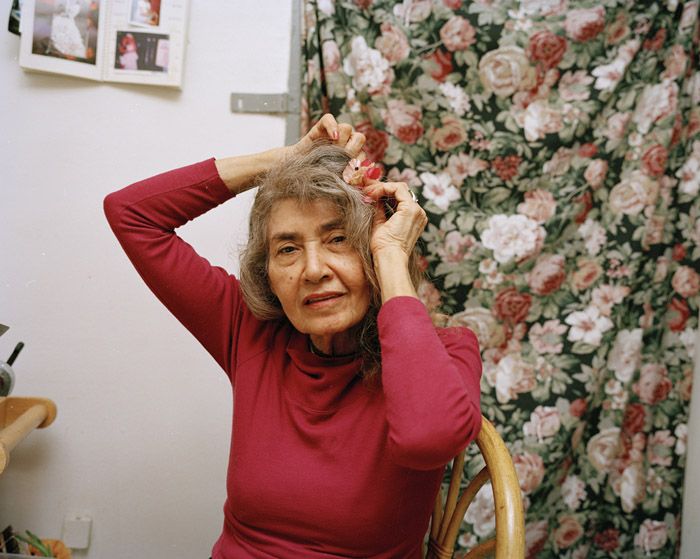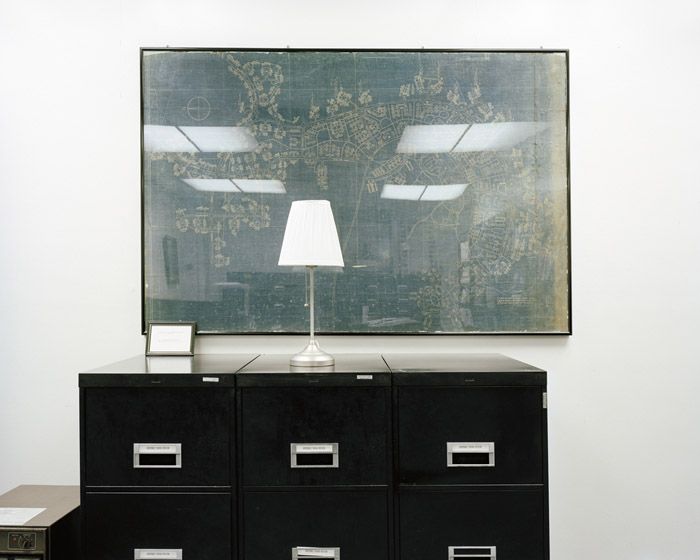blog
Interview with photographer Jason Reblando
F-Stop Magazine: How did you first become involved in photography and what led you to working in this medium?
Jason Reblando: I’ve always enjoyed taking photographs since childhood, but it was mostly for preserving memories and events. I took a photo class at Boston College with Karl Baden, which exposed me to photography as art. This class made a deep and lasting impression on me, but it wasn’t until my late 20’s that I had the confidence to think of photography as my vocation. I have background in sociology and worked as a community organizer and a lung cancer researcher before dedicating myself full-time to photography. While I sometimes wish I made the decision earlier to become a photographer, I know that these prior experiences shaped me as a person and helped me become the photographer I am today.
F-Stop: Your current photography projects are on public housing (New Deal Utopias, Lathrop Homes, Outside Public Housing.) How did your interest in this begin and can you discuss your creative process for making these images?
JR: These bodies of work on public housing originated with a series on youth boxers in Chicago. When I moved to Chicago in 2002 I knew very little about the city’s neighborhoods. I wanted to get to know the city, and had a romantic notion the heart of an urban metropolis beat in the boxing gyms. I visited several boxing clubs that met in the fieldhouses of the Chicago Park District and found that several of the boxers I encountered lived in nearby public housing. I kept hearing stories of displacement as public housing high-rises were being torn down and replaced with mixed-income townhouses. This began my longtime interest in public housing, urban design, and planned communities. The city was going through an enormous transformation, and I was interested in how growth and decline feed off each other.
Regarding my creative process, I invest a lot of time into each project, often returning to the same location and same people so I can nurture relationships and grow a network in an area. I always try to come back with prints to hand out to the people who were generous enough to let me photograph them. Also, while the projects you’re asking about are distinct bodies of work, I can say one begot the other. Outside Public Housing evolved into Lathrop Homes, and Lathrop Homes evolved into New Deal Utopias.
For Outside Public Housing, my original intent was to try and photograph public housing residents that were being displaced, but I was having trouble gaining access. However, the people I did keep encountering were the ring of people whose professions were intertwined with public housing – demolition workers, social workers, activists, lawyers, and so on. I thought it would be interesting to turn the camera outwards towards these workers and focus on the people who were moving the chess pieces around, instead of the chess pieces themselves.
I photographed residents at Stateway Gardens, a high-rise complex on the South Side of Chicago for a few years, and shortly after it was demolished I found out about Lathrop Homes, a public housing development on the North Side that was atypical public housing. Lathrop Homes is a complex of low-rise brick buildings with lush courtyards, not a monolithic high-rise complex often associated with the failure of public housing, such as the ill-fated Pruitt-Igoe project in St. Louis and Cabrini-Green in Chicago. I made connections with residents and became involved with the community organizers who were advocating for the preservation of Lathrop Homes, as it, too, is targeted for demolition. I was motivated to make pictures there for the purposes of preservation and photograph the lives of residents, but I was also curious about its history, architecture, and design. I discovered that it was built as part of the New Deal, and that its layout and design were inspired by “Garden City” principles, which led me to find out about the Greenbelt Towns.
I was excited to zoom out both geographically and conceptually, and proceeded to make several trips to Greenbelt, Maryland; Greenhills, Ohio; and Greendale, Wisconsin over the next few years. I wanted to focus on the utopian aspects of how and why they were conceived. They have a rich and controversial history. Amidst the towns’ planning and construction, conservative members of Congress and business leaders accused the planners of being “socialist” and “communist” due to the government’s involvement in the housing industry. Much of the same vitriol is being used today, as we grapple with how big a role government should play in people’s lives.
F-Stop: For your projects on Lathrop Homes and Outside Public Housing were the people you photographed supportive of your project and keen to take part? When taking photos of the people involved in these two projects what differences in their reactions did you notice?
JR: I’m hyper-aware of the fact that I am an outsider to these communities and am sensitive to the politics of representation. I also don’t make any attempt to believe that I am just a fly-on-the-wall observer or that my presence doesn’t affect their behavior. The introduction of a camera into any situation, even when people know each other intimately, changes the dynamics between people. Society by and large expects a lot from photography due to its highly descriptive nature. While photographs appear straightforward, they are anything but objective documents. I think it’s an interesting space to occupy.
Having said that, the people who are depicted in Lathrop Homes and Outside Public Housing were very willing participants. I came away with the impression that everyone enjoyed someone who was genuinely listening to them talk about their work and life, while also paying close visual attention to them. Of course, the viewer doesn’t see how many times I got turned down for one reason or another. For Outside Public Housing, there is a glaring absence of anyone from the Chicago Housing Authority, who repeatedly rejected my requests as I’m sure they didn’t want to be subject to my scrutiny. For Lathrop Homes, every now and then someone would suspect that I was an undercover cop. I actually don’t mind people being suspicious of someone with a camera. People have every right to know the reason for a camera’s presence. However, to automatically jump to the conclusion that I was a police officer was troubling as it revealed a deep mistrust between the community and a police force that is supposed to be protecting and serving them.
F-Stop: Public housing is throughout the developed world. How do you make your project relatable to someone elsewhere in the world? Is that something you think about when putting a project together?
JR: I don’t necessarily have this in the forefront of my mind when I am thinking about a project. However, I do hope that the visual appeal of the images and the commentary on the human condition would appeal to anyone regardless of national origin. I hope that viewers can relate to themes of home, place, and work, even if they aren’t familiar with public housing issues.
F-Stop: You photograph in cities; do you think “city photography” always has to be about the architecture and people? What other aspects of a city can be shown through photography or do you show through your photography?
JR: I think that by and large “city photography” at least alludes to the sheer magnitude and concentration of people in a circumscribed area. The diversity of aspects of a city that can be shown through photography is limitless. Bruce Davidson alone covers a wide spectrum of the urban condition ranging from Central Park to Subway to East 100th Street. A photographer can retreat from the hustle and bustle that cities are known for and focus on rooftop gardens; or they can focus on the seedy underbelly of the drug underworld; and everything between.
On the surface, my project New Deal Utopias doesn’t look like it’s about cities, when in fact it is very much so. The 1939 film The City hailed the Greenbelt Town as “The City of Tomorrow” and was presented as a model of innovative urban planning at the 1939 World’s Fair. The towns were not only conceived as an antidote to overcrowded urban slums, but also as a way to help pull America out of the Great Depression. The buildings and social spaces were designed to promote egalitarian community values, a response to the individualism that brought on and accentuated the Depression.
F-Stop: You’ve been in two exhibitions this year with these collections in Illinois. Do you enjoy the experience of putting together an exhibition and sharing your photos with an audience in this way?
JR: Absolutely. Even though the web has become an easy and essential way to share and distribute work, I still enjoy the craft of making and exhibiting prints. There is a tactile and finite quality to a final print that I like to experience. I also still enjoy the social aspect of bringing people together for an event and having face-to-face contact with people who have questions, praise, and criticism about my work. The web might be just as fruitful as an art opening, but having a wine and cheese reception on the Internet can be challenging.
F-Stop: What do you hope people see, feel or perhaps learn when they look at your photographs? What feedback or reactions have you received?
JR: I hope viewers experience something that they did not expect. My wish is predicated on the one-dimensional view of certain issues that is often put forth by media, which often doesn’t have the time or desire to explore the nuances and subtleties of a complex issue such as public housing. For instance, most public housing stories are placed in the framework of gang violence that occur within neglected high-rises. While I don’t deny this happens, I hope that viewers appreciate a different twist on public housing when I explored the economic and professional matrix that relies on the public housing industry.
When people react to the Lathrop Homes series, not only are they surprised that it is still occupied, but they are also surprised that such a diverse population lives there. It’s very easy to drive by and write it off, so it pleases me that my photos shed some new light on them. When residents of the Greenbelt Towns see my New Deal Utopias series, they’re often puzzled at how unpopulated many of my photos look. It’s almost the opposite reaction – “Wow, people still live at Lathrop?” vs. “Whoa. Where are all the people in Greenbelt?” At Lathrop I wanted to focus on community life, whereas with the Greenbelt Towns, I wanted to focus on the architecture and the planned design of the three communities. These were aesthetic and conceptual decisions.
F-Stop: Are you continuing to develop these projects or do you have any future plans for a new collection?
JR: I try to make it to the Greenbelt towns when I get the chance, but I’ve started to make trips to planned communities whose main feature is workers’ housing, such as the Pullman neighbourhood in Chicago, which housed employees of the Pullman railroad car company, and Kohler, Wisconsin, a town built for employees of Kohler, the manufacturer of plumbing products. I’ve also been to the Garden Cities of Ebenezer Howard in England. I’m very interested in exploring the tension between the ideal and the real. It will be yet another offshoot of an offshoot.
F-Stop: What photographers or other artists inspire you?
JR: I’m particularly inspired by the portraits by Dawoud Bey, August Sander, Rineke Dijkstra, Katy Grannan, and Alec Soth. I always find inspiration in the landscapes of Terry Evans, Robert Adams, Jem Southam, and Edgar Martins. Lately I’ve been enjoying Adam Broomberg and Oliver Chanarin, Richard Mosse, and Robin Rohde. I’ve also found The Life and Death of Great American Cities by Jane Jacobs incredibly insightful.
F-Stop: What has been the best career advice you’ve received? What advice do you have for someone with an active interest in photography?
JR: E. L. Doctorow has described his writing process “like driving a car at night—you never see further than your headlights, but you can make the whole trip that way.” This was neither career advice nor did I receive it from him, but it gives me comfort when I don’t know what’s around the corner and that I need to keep driving.
My advice for someone who has an active interest in photography is that everyone should have a trusted critique group. Photography is often an independent endeavor, but it’s difficult to exist in a vacuum. Having a creative community that can give you honest feedback is indispensable.
For more of Jason Reblando’s work: www.jasonreblando.com

Jason Reblando – Doretha Connor, Horner Homes resident senior advocate, from the series Outside Public Housing
Events by Location
Post Categories
Tags
- Abstract
- Alternative process
- Architecture
- Artist Talk
- artistic residency
- Biennial
- Black and White
- Book Fair
- Car culture
- Charity
- Childhood
- Children
- Cities
- Collaboration
- Community
- Cyanotype
- Documentary
- Environment
- Event
- Exhibition
- Faith
- Family
- Fashion
- Festival
- Film Review
- Food
- Friendship
- FStop20th
- Gender
- Gun Culture
- Habitat
- Hom
- home
- journal
- Landscapes
- Lecture
- Love
- Masculinity
- Mental Health
- Migration
- Museums
- Music
- Nature
- Night
- nuclear
- p
- photographic residency
- Photomontage
- Plants
- Podcast
- Portraits
- Prairies
- Religion
- River
- Still Life
- Street Photography
- Tourism
- UFO
- Water
- Zine








Leave a Reply